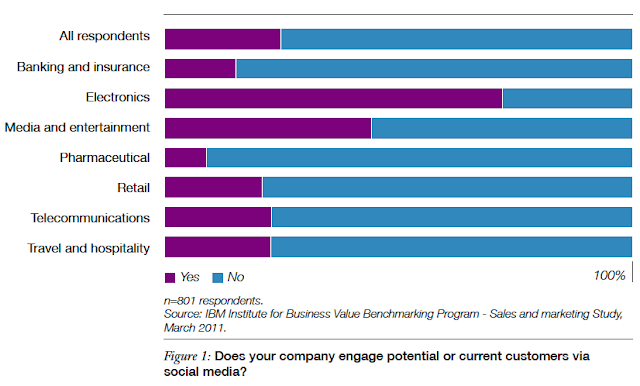Some pharma pundits — mostly consultants who want more pharma clients — see great potential for pharma to use social media such as Twitter and Facebook to “engage” consumers and patients.
Yet, pharma is lagging behind other industries in its use of social media for engaging customers (see chart below). That’s one takeaway of a benchmarking survey conducted by IBM in early 2011. The survey polled eight hundred sales and marketing managers (including 88 from pharma companies) who, provided information about their organizations’ key practices and performance indicators. You can find the full survey report here.
Why is this?
Most people will claim that FDA regulations and lack of guidance are the main culprits. Keep in mind, however, that FDA regulates only branded communications between pharma and consumers or physicians. There are plenty of ways that pharma can use social media to engage without mentioning brands. See, for example, “Supporting Patients via Twitter and Beyond” in this month’s Pharma Marketing News (subscription required).
So why isn’t pharma doing more t o”engage” consumers via non-branded social media?
I think it’s because pharma has a long tradition of engaging their clients (patients and physicians) the old-fashioned way – in person. Obviously, pharma sales reps have always engaged physicians through personal contact. It’s only recently that this kind of activity has been scaled back. Some of the pundits I refer to above would say that’s because of the ascendancy of “non-personal” (ie, digital) promtion (see, for example, “Building the ‘New’ Pharma Physician Marketing Model” (pdf; no subscription required).
But a lot of the scaling back of sales reps in the field is due to the fact that there were TOO MANY sales reps calling on the same doctors promoting the same products. Many physicians have grown weary of that practice (sales “pods”) and put limits on when sales reps can see them (see “Are Sales Reps Necessary?“).
What about consumer/patient engagement?
Pharma also has a long tradition of engaging patients in the REAL world such as through support of patient advocacy groups and disease awareness campaigns. Pharma uses Twitter to promote these activities. An example is this one from @GSKUS: “Nearly 100 #GSKvolunteers embark on life changing assignments to*build healthy communities all over the world.**http://t.co/FloiUmmi*”
So, social media is often used by pharma to promote its real-world engagement with patients and consumers. But social media is used for promotion — one-way communication — not for two-way engagement.
Personally, I think this is a good use of social media by pharma. But it’s not going to bring a lot of business to consultants who want to do more engagement exclusively via social media (i.e., “non-personal engagement”).









![6 Digital Tools at the Center of Healthcare Digitalization [INFOGRAPHIC]](http://ec2-54-175-84-28.compute-1.amazonaws.com/pharma-mkting.com/wp-content/uploads/2021/04/6DigitalTools_600px-100x70.jpg)




